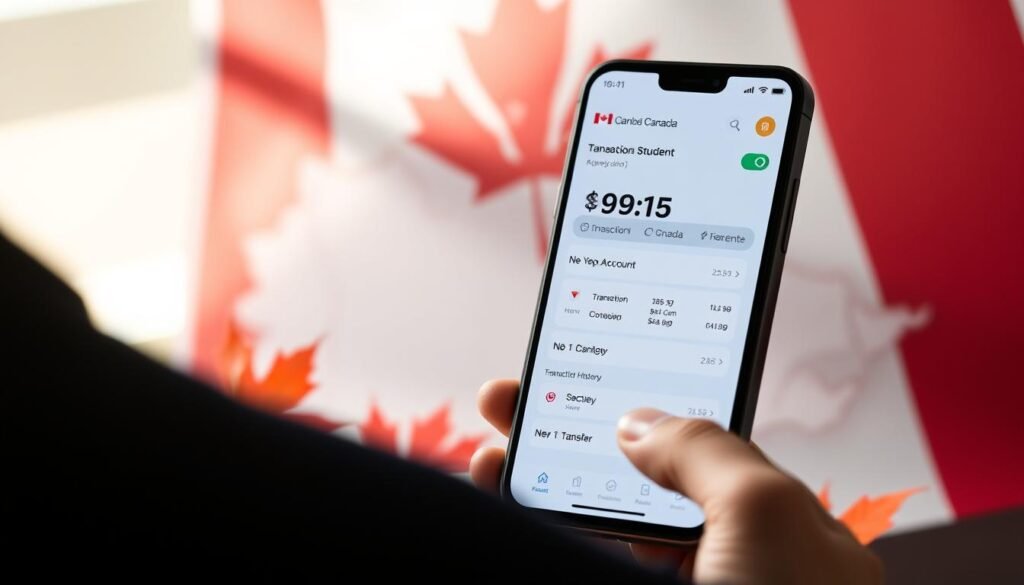
Best Savings Account for International Students in Canada

You’re choosing a bank that helps you store money, get paid and move funds without friction while you study. This short guide helps you compare offers, spot fees, and pick the right product from major banks and digital challengers.
Expect clear checklists on what ID to bring, how to open a bank account, and which government rules like the SDS GIC affect your plan.
Throughout, you’ll find practical steps, links to and pointers to official pages Canada.ca. Use these tips to open the right bank account and keep fees low from day one.
- Start here: What you need from a student bank in Canada right now
- How to choose a student bank and savings account like a pro
- savings account for international students Canada: best features to prioritise
- Compare top banks and accounts: Big Six and digital challengers
- Build credit while you save: student credit cards, lines of credit, and money transfers
- Open your Canadian student account step‑by‑step
- Your next steps to lock in the right account and start saving
Start here: What you need from a student bank in Canada right now
Start by choosing a bank that gives you clear fees, strong mobile tools, and easy debit access near campus.
Buyer’s snapshot: fees, interest, and unlimited transactions that matter
Put unlimited transactions at the top of your list. That keeps daily spending, Interac e‑Transfers and bill payments from adding bite‑size charges to your budget.

Look for a $0 monthly option and a plain list of what’s included. Check whether student status or a minimum balance waives any fee.
- Confirm your debit card works on a large ATM network near campus to avoid non‑network charges.
- Compare promotional interest or bonus rate promos on linked savings, and how easily you can move money between accounts.
- Weigh starter offers like a 125 cash bonus against long‑term costs such as overdraft pricing.
- Pick mobile banking that supports quick e‑Transfers, bill pay and mobile deposits.
Explore student-friendly banking basics at studyfinance.org/banking before you shortlist two or three banks to visit.
How to choose a student bank and savings account like a pro
Start by matching what you use daily with the account perks you'll actually need.
Chequing vs. savings vs. high‑interest savings
Use a chequing account for daily spending, bills and e‑Transfers. Most student chequing plans include unlimited transactions and no monthly fee.
Keep longer‑term funds in a savings account or a high‑interest savings option at a digital bank to earn interest on money you won’t touch that week.

Eligibility, minimum balance and included transactions
Check the bank's requirements: proof of enrolment, passport and your study permit are typical. Confirm any minimum balance that unlocks extras.
Compare how many free transactions you get and whether e‑Transfers are unlimited or charge per transfer.
SDS and GIC essentials
Under the student direct stream, set up your international student gic or student gic (C$20,635) early to speed study permit processing.
Shortlist two chequing options and one savings option with clear rates, easy linking and predictable fees before you visit a branch.
savings account for international students Canada: best features to prioritise
Choose tools that make everyday transfers simple and keep your funds growing without surprises.
Pick an option that gives a competitive ongoing rate plus a clear bonus period. Digital banks often pay higher interest with no monthly fee and let you link a chequing account so transfers are instant. Traditional banks may offer a short bonus and overdraft protection, but that protection can carry a cost.

Interest, linking and easy transfers
Make sure you can link your chequing to move money instantly via app transfers. Set automatic sweeps after payday so you build a buffer without thinking about it.
Fee traps to avoid
- Avoid non‑network ATM withdrawals and check your bank's locator before you travel.
- Watch excess transactions that step outside your plan; they add up quickly.
- Understand overdraft pricing and whether a minimum balance is needed to earn a higher rate.
Simple rule: hold one week of spending in chequing and route the rest out of sight into savings. Review balances every Sunday and use apps with spend categories to funnel extra cash to long‑term goals.
"Aim for clarity: published limits, daily interest methods and clear debit network rules matter more than a flashy signup bonus."
Compare top banks and accounts: Big Six and digital challengers
Compare major banks and digital challengers to find the mix of branches, fees and app features that suit you.
Big Six banks offer wide ATM reach, $0 student chequing and newcomer perks. TD, RBC, Scotiabank, BMO, CIBC and National Bank each publish student promos, overdraft options and branch support for an international student bank setup.
Digital challengers like KOHO, EQ Bank, Tangerine, PC Money and Wealthsimple focus on higher interest, no monthly fees and slick apps. They often include unlimited transactions and simpler fee schedules.
Quick checklist before you pick
- Confirm ATM network near campus and non‑network fees.
- Check promo length (e.g., six months) and post‑promo rate.
- See if Interac e‑Transfers are unlimited and low‑cost.
- Match a chequing with an easy credit card path to build credit.
| Provider | Student chequing | Savings/HISA | Bonus | ATM network |
|---|---|---|---|---|
| TD | No monthly fee, unlimited transactions | 6‑month promo options | Promotional cash bonus | Large national network |
| RBC | $0 student plan, branch support | Linked HISA offers | Varies by promo | Extensive network |
| EQ Bank | Unlimited transactions, app-first | High interest ongoing rate | Minimal signup bonuses | ABM partnerships |
| Tangerine | No‑Fee Daily Chequing | Competitive HISA | Occasional cash offers | Scotiabank ABMs |
| Wealthsimple | High interest chequing, FX perks | High interest options | Referral bonuses | Interac network |
External references: Government SDS page; official bank offer pages and TD International Student GIC info. Use them to confirm current terms before you sign up.
Build credit while you save: student credit cards, lines of credit, and money transfers
A low‑limit starter card and consistent payments are the fastest, safest ways to create a credit history. Start simple and be steady: the goal is on‑time payments and low utilisation.
Starter credit cards and responsible use
Begin with a student credit card or a secured option that offers a low limit. Pay the balance in full each month to avoid interest and build positive credit.
Keep utilisation under 30% and set up autopay from your bank to prevent missed due dates. Track your score in‑app when available.
Interac e‑Transfer and low‑fee remittances
Use Interac e‑Transfer for day‑to‑day money requests and repayments. Confirm your plan includes unlimited transactions so you aren’t charged per transfer.
If a bank refunds a Visa Direct fee or offers remittance promos, use them to lower the cost of sending money while you settle in.
- Separate spending: use your card for purchases and keep emergency funds tucked away.
- Ask about bundled banking packages that add fee waivers or extra e‑Transfer limits.
- Check foreign transaction fees if you plan to spend abroad.
"Start small, pay on time, and let steady behaviour do the heavy lifting for your credit profile."
Compare student credit cards and secured options at studyfinance before you apply.
| Product | Who it's best for | Key benefit | Typical fee |
|---|---|---|---|
| Low‑limit student card | Newcomers with no history | Build credit with low risk | $0–$25 annual |
| Secured card | Rebuilding credit | Deposit backs your limit | One‑time deposit |
| Bundled student package | Students needing unlimited transfers | Fee waivers and perks | Often $0 with student ID |
Open your Canadian student account step‑by‑step
Getting your banking set up should feel simple and secure follow this short checklist and you’ll be ready to pay tuition, receive funds and use your debit card fast.
Document checklist
Bring two pieces of ID: your passport and study permit (IMM 1442 / 1208 / 1102).
Also carry proof of enrolment on official letterhead showing your full name, institution, program and start year. Some banks may ask for a secondary ID.
Apply online vs in‑branch
Start online to save time, but plan to finish verification in person if required. In‑branch opening often lets you get a card the same day; online starts can take a few days to a week.
Ask how the bank activates debit cards by phone, app or at a branch and confirm any first deposit or minimum deposit requirements.
Quick checklist before you finish
- Passport, study permit and proof of enrolment ready as digital scans and originals.
- Book a branch appointment if you want same‑day card pickup.
- Decide SDS (student direct stream) + student gic route or the standard opening path.
- Request a student chequing plus a linked savings so transfers are instant and transactions count correctly.
Side‑by‑side comparison
| Step | Student direct stream (SDS) + student gic | Standard in‑branch opening |
|---|---|---|
| Initial action | Buy an international student gic and fund (C$20,635) | Bring passport, permit and proof to a branch or start online |
| Documents | GIC confirmation letter + passport + study permit | Passport + study permit + proof of enrolment |
| Funding | Pre‑fund from home country; bank holds GIC | Make a first deposit on arrival (varies by bank) |
| Months to completion | Often faster visa processing under student direct stream | Typically same day to a few weeks, depending on verification |
| Debit card activation | Card ready in branch after arrival; some banks link to GIC access | Often instant in branch or after online activation |
GIC confirmation
Final steps: make your first deposit, enable mobile banking, and test a small transaction (e.g., a $5 tap). Keep digital copies of all proof and your GIC letter in secure cloud storage.
Your next steps to lock in the right account and start saving
Start by choosing a primary bank for daily payments and a second digital provider to grow leftover funds.
Shortlist two or three student bank accounts one Big Six for ATM reach and one digital with $0 fees and higher returns. Check bonus terms (including any 125 cash bonus) and confirm requirements like direct deposit or minimum balance before you sign.
Open a chequing account first, then link a high‑rate option so you can automate transfers and keep unlimited transactions on your main plan. If you qualify for SDS, set up your international student gic and keep the student gic paperwork handy.
Take 30 minutes to test the app: make a small transaction, set goals and enable alerts. Learn more at student banking guide and compare cards at student credit options. Reassess in three months and switch if promos or terms change.
If you want to know other articles similar to Best Savings Account for International Students in Canada you can visit the category Finance.






Leave a Reply